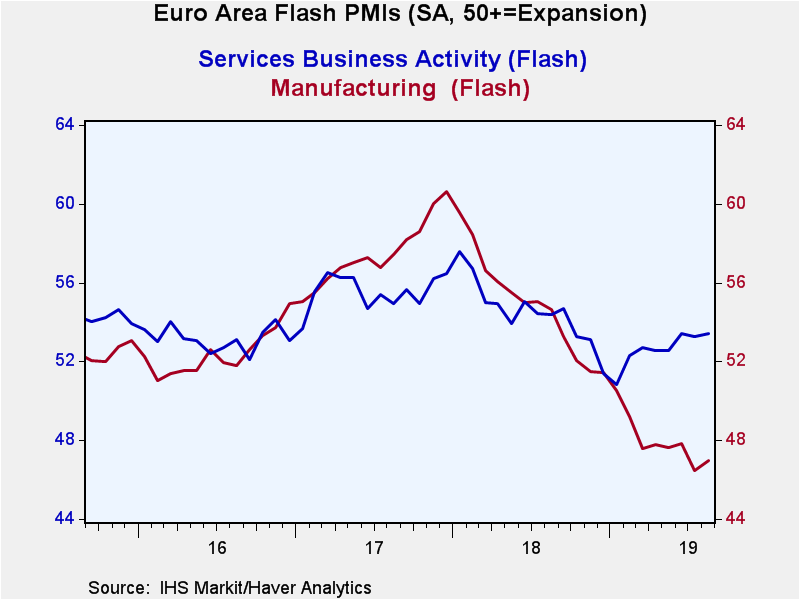 Global| Aug 22 2019
Global| Aug 22 2019Some PMI Improvement But Not Much Change in Europe
Summary
EMU readings for August show a clear but minor sense of stabilization. The service sector reading that had been rising has slowed and is back to its June level. Manufacturing's PMI moved higher in August but still below its June [...]
 EMU readings for August show a clear but minor sense of stabilization. The service sector reading that had been rising has slowed and is back to its June level. Manufacturing's PMI moved higher in August but still below its June level. The sequential EMU readings show steady manufacturing deterioration. The services sector has been extremely stable on these metrics but at weak readings. It has a month-by-month trend that is working higher. Manufacturing has slipped into a moderate contracting reading. It is near the lowest reading since January 2015, but in recessionary episodes this reading will get much weaker.
EMU readings for August show a clear but minor sense of stabilization. The service sector reading that had been rising has slowed and is back to its June level. Manufacturing's PMI moved higher in August but still below its June level. The sequential EMU readings show steady manufacturing deterioration. The services sector has been extremely stable on these metrics but at weak readings. It has a month-by-month trend that is working higher. Manufacturing has slipped into a moderate contracting reading. It is near the lowest reading since January 2015, but in recessionary episodes this reading will get much weaker.
Germany's composite index is at its low mark since January 2015. Manufacturing is just off its low for this period while services have a 41.1 percentile standing. The German service sector reading has improved from its weakest reading but then has gone flat. Manufacturing while off its low is still in an eroding trend.
France is doing considerably better. Its PMI raw diffusion readings are not stronger than those for the EMU or Germany except for manufacturing. But its PMI rankings are much stronger. Even so, the French PMI rankings are only moderate with their strongest rankings for the services sector barely above their median values on data back to January 1995. The French composite reading is at is median. The French services sector monthly is clawing its way higher while French manufacturing is only moving sideways at a weak level
Japan shows extreme bifurcation. Its manufacturing sector is contracting with a ranking in its lower 16th percentile. But Japan's services reading at 53.4 in August stands at its 94.6 percentile. That combination puts the Japanese composite index at its 50th percentile, right at its median value on data back to January 2015.
The U.S. shows weak readings in August on the Markit scale. It shows consistent and steady deterioration in various sectors on its averages from 12-months to six-months to three-months. The composite index has a 5.4 percentile standing on the weakest manufacturing reading on this timeline and a service sector reading in its 3.6 percentile. The U.S. is now a clear and unambiguous picture of weakness. Only manufacturing is contracting, but service sector contraction is not far away with a diffusion reading of 50.9 in August.
The Markit data for the U.S. have consistently been weaker than the readings from the ISM surveys. But evaluated on the same timeline, their respective queue rankings are quite similar and weak.
The slowing in the decay of the PMI readings and the slow recovery in the case of France may be signs that the trade war impact is wearing off. Or it may just be a lull in a still virulent storm of weakness. PMI readings tend to be very sensitive so the hiatus in trend may not be a major trend change since these readings can be so easily blown off course. I suspect that weakness will continue since there is too much of it and nothing discernable has happened to turn things around.
Robert Brusca
AuthorMore in Author Profile »Robert A. Brusca is Chief Economist of Fact and Opinion Economics, a consulting firm he founded in Manhattan. He has been an economist on Wall Street for over 25 years. He has visited central banking and large institutional clients in over 30 countries in his career as an economist. Mr. Brusca was a Divisional Research Chief at the Federal Reserve Bank of NY (Chief of the International Financial markets Division), a Fed Watcher at Irving Trust and Chief Economist at Nikko Securities International. He is widely quoted and appears in various media. Mr. Brusca holds an MA and Ph.D. in economics from Michigan State University and a BA in Economics from the University of Michigan. His research pursues his strong interests in non aligned policy economics as well as international economics. FAO Economics’ research targets investors to assist them in making better investment decisions in stocks, bonds and in a variety of international assets. The company does not manage money and has no conflicts in giving economic advice.






